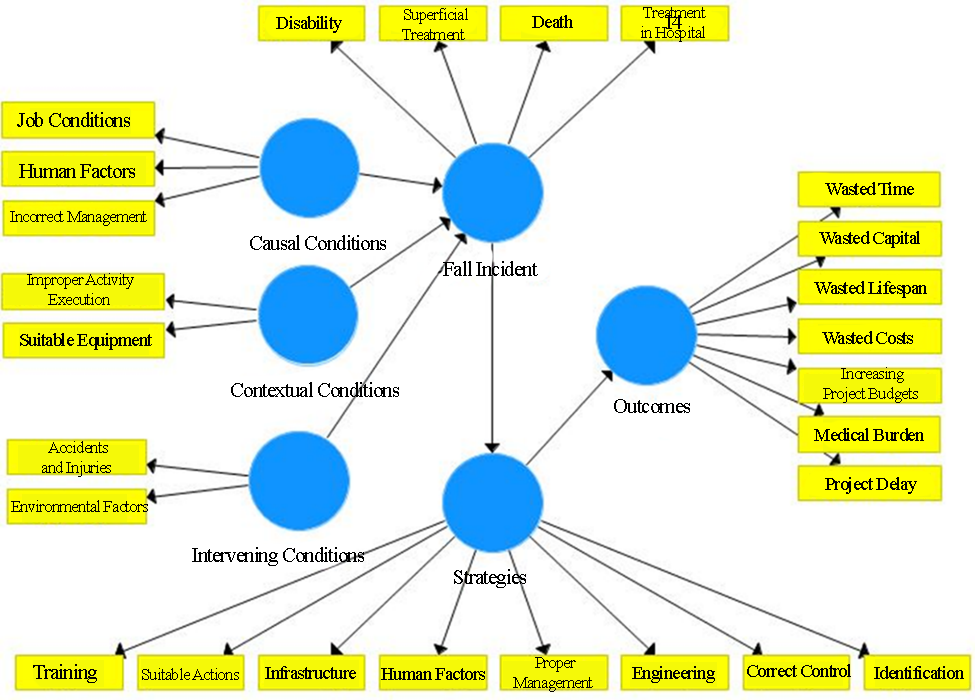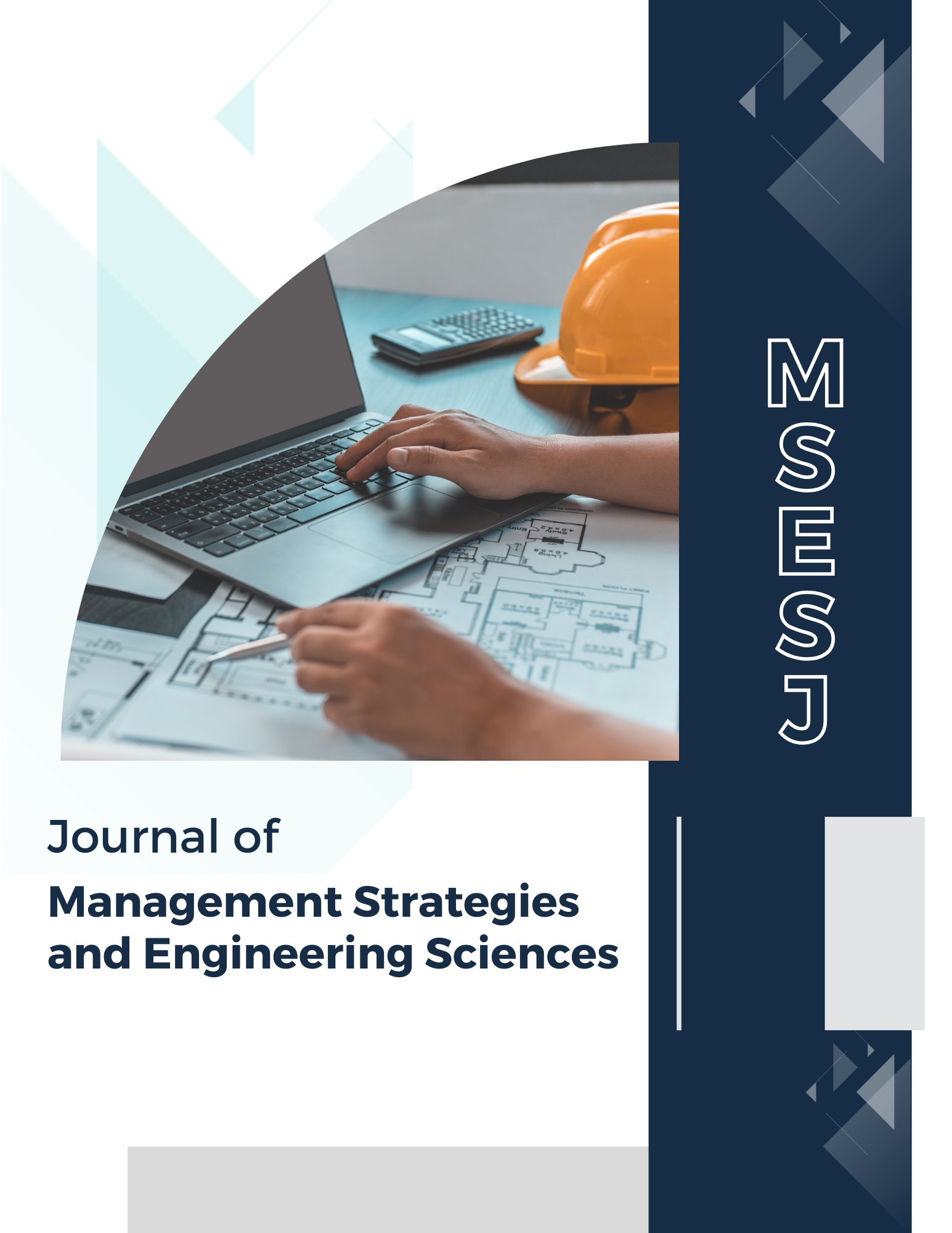Development of a Paradigmatic Model of Fall Incident-Related Injuries Based on Comprehensive Data in Residential Construction Projects
Keywords:
Paradigm model, fall accidents, causal conditions, contextual conditions, interventional conditionsAbstract
Falls are a significant public health risk and a leading cause of both fatal and non-fatal injuries among construction workers worldwide. A more comprehensive understanding of the causal factors contributing to fall incidents is essential for preventing falls in the construction industry. However, there is no general review of causal factors in the existing literature. Given the importance of addressing accidents and incidents in the construction industry, this study aims to develop a paradigmatic model of injuries caused by fall incidents based on comprehensive data from the residential construction sector. The main objectives of this research include identifying the injuries and factors influencing falls in the construction industry, developing a model, and providing solutions to reduce fall risks. The research methodology is content analysis, using a qualitative approach. To extract the factors influencing fall risk management, the meta-synthesis approach is employed. For data analysis in the qualitative section, 110 codes were derived from 48 domestic and international articles that met the criteria for relevance and quality, which were then combined to present an overall view. Following coding and identification of new factors, validity was assessed using the fuzzy Delphi technique, with consultation from 15 experts in Tehran. After validation of the indicators, the paradigmatic model was developed, which illustrates that causal, contextual, and intervening conditions lead to the occurrence of incidents. Along with appropriate strategies, these factors can control or mitigate various consequences. These findings contribute to research on the causes of falls in construction, the development of engineering controls, policy-making, intervention design to reduce fall risks, and the improvement of research synthesis methods.
References
T. M. Mutegi, P. M. Joshua, and J. K. Maina, "Workplace Safety, Employee Safety Attitudes and Employee Productivity of Manufacturing Firms," Sa Journal of Human Resource Management, 2023, doi: 10.4102/sajhrm.v21i0.1989.
M. C. Schall, R. Sesek, and L. Cavuoto, "Barriers to the Adoption of Wearable Sensors in the Workplace: A Survey of Occupational Safety and Health Professionals," Human Factors the Journal of the Human Factors and Ergonomics Society, 2018, doi: 10.1177/0018720817753907.
P. Yung, "Institutional arrangements and construction safety in China: an empirical examination," Construction Management and Economics, vol. 27, no. 5, pp. 439-450, 2009, doi: 10.1080/01446190902855633.
T. S. Abdelhamid and J. G. Everett, "Identifying root causes of construction accidents," Journal of Construction Engineering and Management, vol. 126, no. 1, pp. 52-60, 2000, doi: 10.1061/(ASCE)0733-9364(2000)126:1(52).
D. N. M. A. Abdullah and G. C. M. Wern, "An analysis of accidents statistics in Malaysian construction sector," Hong Kong, 2011, vol. 3: IACSIT Press, 1 ed., pp. 1-4. [Online]. Available: https://www.bartleby.com/essay/Analysis-of-Accidents-Statistics-in-Malaysian-Construction-F3PUFCE36YYS.
M. K. Zekri, "Construction Safety and Health in Dubai," Heriot Watt University, Edinburg Scotland, 2014. [Online]. Available: https://www.researchgate.net/publication/255963895_CONSTRUCTION_SAFETY_AND_HEALTH_PERFORMANCE_IN_DUBAI
A. R. A. Hamid, M. Z. A. Majid, and B. Singh, "Causes of accidents at construction sites," Malaysian Journal of Civil Engineering, vol. 20, no. 2, pp. 242-259, 2008. [Online]. Available: https://journals.utm.my/mjce/article/view/15769.
T. K. Courtney, G. S. Sorock, D. P. Manning, J. W. Collins, and M. A. Holbein-Jenny, "Occupational slip, trip, and fall-related injuries can the contribution of slipperiness be isolated?," Ergonomics, vol. 44, no. 13, pp. 1118-1137, 2001, doi: 10.1080/00140130110085538.
R. A. Haslam et al., "Contributing factors in construction accidents," Applied Ergonomics, vol. 36, no. 4, pp. 401-415, 2005, doi: 10.1016/j.apergo.2004.12.002.
J. Stranks, Human factors and behavioural safety. Routledge, 2007.
H. W. Heinrich, Industrial Accident Prevention, 4th edition ed. New York: McGraw-Hill, 1959.
S. G. Bizzell, "Safety Practices of Small To Medium-Sized Construction Firms," University of Florida, 2008. [Online]. Available: https://ufdc.ufl.edu/UFE0022192/00001/stats
D. Petersen, "Safety management 2000: Our strengths & weaknesses," Professional Safety, vol. 45, no. 1, p. 16, 2000. [Online]. Available: https://aeasseincludes.assp.org/professionalsafety/pastissues/045/01/017010re.pdf.
I. B. Horwitz and B. P. McCall, "Disabling and fatal occupational claim rates, risks, and costs in the Oregon construction industry 1990-1997," Journal of Occupational and Environmental Hygiene, vol. 1, no. 10, pp. 688-698, 2004, doi: 10.1080/15459620490508787.
M. A. Friend and J. P. Kohn, Fundamentals of Occupational Safety and Health. Rowman & Littlefield, 2018.
D. N. Kolo, "Safety issues involving workers on building construction sites in Nigeria: An Abuja study," Eastern Mediterranean University (EMU)-Doğu Akdeniz Üniversitesi (DAÜ), 2015. [Online]. Available: http://i-rep.emu.edu.tr:8080/jspui/bitstream/11129/1724/1/KoloDaniel.pdf
S. C. Moyce and M. Schenker, "Migrant workers and their occupational health and safety," Annual Review of Public Health, vol. 39, pp. 351-365, 2018, doi: 10.1146/annurev-publhealth-040617-013714.
Z. O. Kadiri et al., "Causes and effects of accidents on construction sites (a case study of some selected construction firms in Abuja FCT Nigeria)," IOSR Journal of Mechanical and Civil Engineering, vol. 11, no. 5, pp. 66-72, 2014, doi: 10.9790/1684-11516672.
I. M. Earl, "OSHA Statistics for Construction Site Injuries and Death," 2010.
W. J. Meerding, S. Mulder, and E. F. Van Beeck, "Incidence and costs of injuries in The Netherlands," The European Journal of Public Health, vol. 16, no. 3, pp. 271-277, 2006, doi: 10.1093/eurpub/ckl006.
S. C. Kwon, "Use of frequency analysis of exposure of hazards by occupations: Findings from the third and fourth Korean working conditions survey," Soonchunhyang Medical Science, vol. 25, no. 1, pp. 37-45, 2019, doi: 10.15746/sms.19.006.
M. Hallowell, "Cost‐effectiveness of construction safety programme elements," Construction Management and Economics, vol. 28, no. 1, pp. 25-34, 2010, doi: 10.1080/01446190903460706.
C. Y. Cheah, "Construction safety and health factors at the industry level: The case of Singapore," Journal of Construction in Developing Countries, vol. 12, no. 2, 2007. [Online]. Available: https://www.researchgate.net/profile/Nirmala-Svsg/post/What_is_the_safety_attitude_of_contractors_like_in_Singapore/attachment/59d63e0279197b807799ab33/AS%3A422167516061696%401477663987252/download/Construction+Safety+and+Health+Factors+at+the+Industry+Level.pdf.
A. P. Chan et al., "Work at height fatalities in the repair, maintenance, alteration, and addition works," Journal of Construction Engineering and Management, vol. 134, no. 7, pp. 527-535, 2008, doi: 10.1061/(ASCE)0733-9364(2008)134:7(527).
J. M. Kim, K. K. Lim, S. G. Yum, and S. Son, "A deep learning model development to predict safety accidents for sustainable construction: a case study of fall accidents in South Korea," Sustainability, vol. 14, no. 3, p. 1583, 2022, doi: 10.3390/su14031583.
K. Hu, H. Rahmandad, T. Smith‐Jackson, and W. Winchester, "Factors influencing the risk of falls in the construction industry: a review of the evidence," Construction Management and Economics, vol. 29, no. 4, pp. 397-416, 2011, doi: 10.1080/01446193.2011.558104.
H. J. Im, Y. J. Kwon, S. G. Kim, Y. K. Kim, Y. S. Ju, and H. P. Lee, "The characteristics of fatal occupational injuries in Korea's construction industry, 1997-2004," Safety Science, vol. 47, no. 8, pp. 1159-1162, 2009, doi: 10.1016/j.ssci.2008.11.008.
K. C. Goh, H. H. Goh, M. F. Omar, T. C. Toh, and A. A. M. Zin, "Accidents preventive practice for high-rise construction," 2016, vol. 47, p. 04004, doi: 10.1051/matecconf/20164704004.
J. Sa, D. C. Seo, and S. D. Choi, "Comparison of risk factors for falls from height between commercial and residential roofers," Journal of Safety Research, vol. 40, pp. 1-6, 2009, doi: 10.1016/j.jsr.2008.10.010.
A. Gavious, S. Mizrahi, Y. Shani, and Y. Minchuk, "The costs of industrial accidents for the organization: developing methods and tools for evaluation and cost-benefit analysis of investment in safety," Journal of Loss Prevention in the Process Industries, vol. 22, no. 4, pp. 434-438, 2009, doi: 10.1016/j.jlp.2009.02.008.
I. Gavious and M. Russ, "The valuation implications of human capital in transactions on and outside the exchange," Advances in Accounting, vol. 25, pp. 165-173, 2009, doi: 10.1016/j.adiac.2009.09.004.












